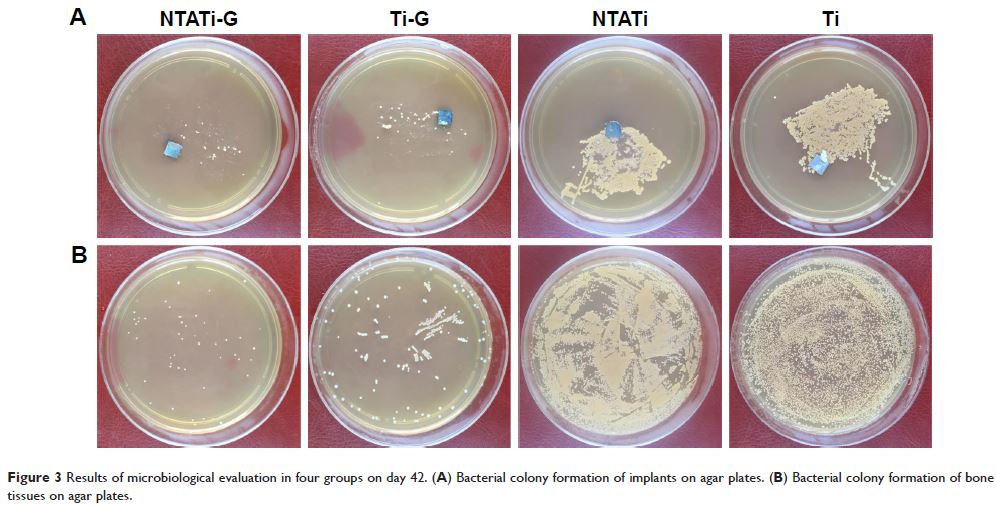9 0 8 0 2
论文已发表
注册即可获取德孚的最新动态
IF 收录期刊
- 2.6 Breast Cancer (Dove Med Press)
- 3.9 Clin Epidemiol
- 3.3 Cancer Manag Res
- 3.9 Infect Drug Resist
- 3.6 Clin Interv Aging
- 4.8 Drug Des Dev Ther
- 2.8 Int J Chronic Obstr
- 8.0 Int J Nanomed
- 2.3 Int J Women's Health
- 3.2 Neuropsych Dis Treat
- 4.0 OncoTargets Ther
- 2.2 Patient Prefer Adher
- 2.8 Ther Clin Risk Manag
- 2.7 J Pain Res
- 3.3 Diabet Metab Synd Ob
- 4.3 Psychol Res Behav Ma
- 3.4 Nat Sci Sleep
- 1.9 Pharmgenomics Pers Med
- 3.5 Risk Manag Healthc Policy
- 4.5 J Inflamm Res
- 2.3 Int J Gen Med
- 4.1 J Hepatocell Carcinoma
- 3.2 J Asthma Allergy
- 2.3 Clin Cosmet Investig Dermatol
- 3.3 J Multidiscip Healthc

更正启事 — 阳极氧化的钛植入物形成的纳米管的庆大霉素 (Gentamicin) 涂层可减少与植入物相关的骨髓炎并增强兔子的骨生物相容性
Authors Liu D, He C, Liu Z, Xu W
Received 15 March 2017
Accepted for publication 4 July 2017
Published 31 July 2017 Volume 2017:12 Pages 5461—5471
DOI https://doi.org/10.2147/IJN.S137137
Checked for plagiarism Yes
Review by Single-blind
Peer reviewers approved by Dr Thiruganesh Ramasamy
Peer reviewer comments 3
Editor who approved publication: Dr Lei Yang
Abstract: Titanium
and titanium alloy are widely used as orthopedic implants for their favorable
mechanical properties and satisfactory biocompatibility. The aim of the present
study was to investigate the antibacterial effect and bone cell biocompatibility
of a novel implant made with nanotubular anodized titanium coated with
gentamicin (NTATi-G) through in vivo study in rabbits. The animals were
divided into four groups, each receiving different kinds of implants, that is,
NTATi-G, titanium coated with gentamicin (Ti-G), nanotubular anodized titanium
uncoated with gentamicin (NTATi) and titanium uncoated with gentamicin (Ti).
The results showed that NTATi-G implant prevented implant-related osteomyelitis
and enhanced bone biocompatibility in vivo. Moreover, the body temperature of
rabbits in NTATi-G and Ti-G groups was lower than those in Ti groups, while the
weight of rabbits in NTATi-G and Ti-G groups was heavier than those in NTATi
and Ti groups, respectively. White blood cell counts in NTATi-G group were
lower than NTATi and Ti groups. Features of myelitis were observed by X-ray
films in the NTATi and Ti groups, but not in the NTATi-G and Ti-G groups. The
radiographic scores, which assessed pathology and histopathology in bone
tissues, were significantly lower in the NTATi-G and Ti-G groups than those in
the NTATi and Ti groups, respectively (P <0.05).
Meanwhile, explants and bone tissue culture demonstrated significantly less
bacterial growth in the NTATi-G and Ti-G groups than in the NTATi and Ti
groups, respectively (P <0.01). The
bone volume in NTATi-G group was greater than Ti-G group, and little bone
formation was seen in NTATi and Ti groups.
Keywords: nanotubular anodized titanium, gentamicin, titanium implant, infection,
antibiotic
* 在本文第 5469 页 ‘鸣谢’ 部分的信息不正确。
请点击这里查看详细更正启事
